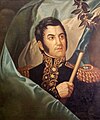Crossing
On the morning of January 19, 1817, San Martin and his army set out from their base camp El Plumerillo and began their journey across the Andes Mountain range. San Martin crossed with 4,000 men, only to end up losing 1/3 of them. The number of auxiliaries reached 1,200.
For the crossing, San Martin split his army into two divisions: The main division, which traveled through the pass of Los Patos, was led by San Martin, Miguel Estanislao Soler and Bernardo O'Higgins. The secondary troop, which traveled through the more southern Uspallata, was led by Juan Gregorio de Las Heras. [8]
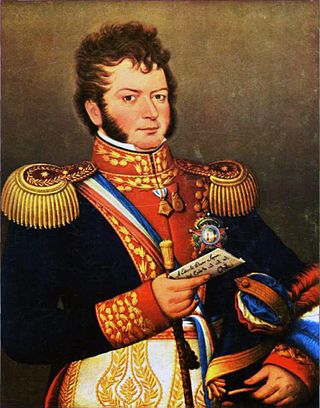
Bernardo O'Higgins Riquelme was a Chilean independence leader who freed Chile from Spanish rule in the Chilean War of Independence. He was a wealthy landowner of Basque-Spanish and Irish ancestry. Although he was the second Supreme Director of Chile (1817–1823), he is considered one of Chile's founding fathers, as he was the first holder of this title to head a fully independent Chilean state.

José Francisco de San Martín y Matorras, nicknamed "the Liberator of Argentina, Chile and Peru", was an Argentine general and the primary leader of the southern and central parts of South America's successful struggle for independence from the Spanish Empire who served as the Protector of Peru. Born in Yapeyú, Corrientes, in modern-day Argentina, he left the Viceroyalty of the Río de la Plata at the early age of seven to study in Málaga, Spain.

José Miguel Carrera Verdugo was a Chilean general, formerly Spanish military, member of the prominent Carrera family, and considered one of the founders of independent Chile. Carrera was the most important leader of the Chilean War of Independence during the period of the Patria Vieja. After the Spanish "Reconquista de Chile" ("Reconquest"), he continued campaigning from exile after defeat. His opposition to the leaders of independent Argentina and Chile, San Martín and O'Higgins respectively, made him live in exile in Montevideo. From Montevideo Carrera traveled to Argentina where he joined the struggle against the unitarians. Carreras' small army was eventually left isolated in the Province of Buenos Aires from the other federalist forces. In this difficult situation Carrera decided to cross to native-controlled lands all the way to Chile to once and for all overthrow Chilean Supreme Director O'Higgins. His passage to Chile, which was his ultimate goal, was opposed by Argentine politicians and he engaged together with indigenous tribes, among them the Ranquel, in a campaign against the southern provinces of Argentina. After the downfall of Carrera's ally, the Republic of Entre Ríos, and several victories against the United Provinces of the Río de la Plata, Carrera's men were finally defeated by numerically superior forces near Mendoza. Carrera was then betrayed by one of his Argentine helpers, leading to his capture and execution in that city.

The Argentine War of Independence was a secessionist civil war fought from 1810 to 1818 by Argentine patriotic forces under Manuel Belgrano, Juan José Castelli, Martin Miguel de Guemes and José de San Martín against royalist forces loyal to the Spanish crown. On July 9, 1816, an assembly met in San Miguel de Tucumán, declaring independence with provisions for a national constitution.

The Battle of Maipú was fought near Santiago, Chile on 5 April 1818, between South American rebels and Spanish royalists, during the Chilean War of Independence. The Patriot rebels led by Argentine general José de San Martín effectively destroyed the Spanish forces commanded by General Mariano Osorio, and completed the independence of the core area of Chile from Spanish domination.

The Battle of Chacabuco, fought during the Chilean War of Independence, occurred on February 12, 1817. The Army of the Andes of the United Provinces of the Río de la Plata, led by Captain–General José de San Martín, defeated a Spanish force led by Rafael Maroto. It was a defeat for the Captaincy General of Chile, the royalist government established after the division of the Viceroyalty of Peru.
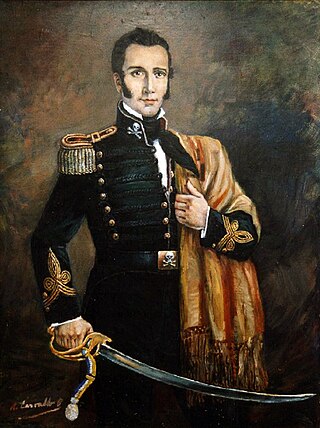
Manuel Xavier Rodríguez Erdoíza was a Chilean lawyer and guerrilla leader, considered one of the founders of independent Chile. Rodríguez was of Basque descent.

The Chilean War of Independence was a military and political event that allowed the emancipation of Chile from the Spanish Monarchy, ending the colonial period and initiating the formation of an independent republic.

Francisco Casimiro Marcó del Pont y Ángel was a Spanish soldier and the last Governor of Chile. He was one of the main figures of the Chilean independence process, being the final Spaniard to rule as Royal Governor of Chile from 1815 to 1817, when he was deposed and captured by the patriot forces after the Battle of Chacabuco.
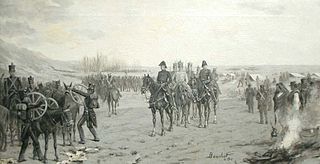
The Army of the Andes was a military force created by the United Provinces of the Río de la Plata (Argentina) and mustered by general José de San Martín in his campaign to free Chile from the Spanish Empire. In 1817, it crossed the Andes Mountains from the Argentine province of Cuyo, and succeeded in its objective by dislodging the Spanish from the country.

Grand Marshal Juan Gregorio de las Heras was an Argentine soldier who took part in the Spanish American wars of independence and was also a governor of the province of Buenos Aires.

Antonio Luis Beruti was an Argentine revolutionary who participated in the May Revolution that started the Argentine War of Independence, and later fought in the Argentine civil wars.

Spanish Reconquest or just Reconquest is the name of a period of Chilean history that started in 1814 with the royalist victory at the Battle of Rancagua and ended in 1817 with the patriot victory at the Battle of Chacabuco.During this period, the defenders of the Spanish Empire reestablished their dominion in Chile after said country had separated itself from the Spanish Crown, installed its First National Government Board in 1810—the first institution of self-government in Chile, created its First Congress National in 1811 and subsequently elected its first supreme director, Francisco de la Lastra, in 1814.
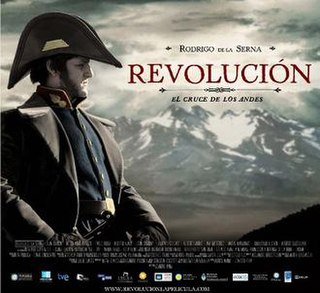
Revolución: el cruce de los Andes is a 2010 Argentine historical epic film directed by Leandro Ipiña and starring Rodrigo de la Serna. It premiered during the bicentennial of Argentina. It was initially named San Martín: el cruce de los Andes.

The Argentina Bicentennial was a series of ceremonies, festivals, and observances celebrated on May 25, 2010, and throughout the year. They commemorated the 200th anniversary of the May Revolution, a sequence of historical events that led to the Viceroy Baltasar Hidalgo de Cisneros being ousted from office and replaced with the Primera Junta, the first national government.

Patria Nueva was a period in the history of Chile that began with the victory of Ejército de los Andes in the Battle of Chacabuco on 12 February 1817 and ended with the resignation of Bernardo O'Higgins as Supreme Director in 1823.

The First Chilean Navy Squadron was the heterogeneous naval force that terminated Spanish colonial rule in the Pacific and protagonized the most important naval actions of in the Latin American wars of independence. The Chilean revolutionary government organized the squadron in order to carry the war to the Viceroyalty of Perú, then the center of Spanish power in South America, and thus secure the independence of Chile and Argentina.
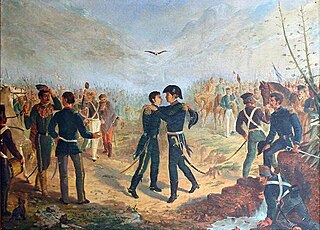
The Yatasto relay was the handover of the command of the Army of the North by Manuel Belgrano to José de San Martín, in January 1814, during the Argentine War of Independence. It is named after the Yatasto relay, a horse relay at the modern Salta Province, but modern historians consider it could have taken place elsewhere.

The Argentine War of Independence was fought from 1810 to 1818 by Argentine patriotic forces under Manuel Belgrano, Juan José Castelli and José de San Martín against royalist forces loyal to the Spanish crown. On July 9, 1816, an assembly met in San Miguel de Tucumán, declared full independence with provisions for a national constitution.

José de San Martín is the national hero of Argentina, Chile and Peru, and along with Simón Bolívar, the most important Libertador of the Spanish American Wars of Independence. For this reason, he is paid homage and depicted in several cultural works of those countries, and even internationally. He led the Campaign across the Andes from Argentina to Chile which has been studied around the world for its complexity.




